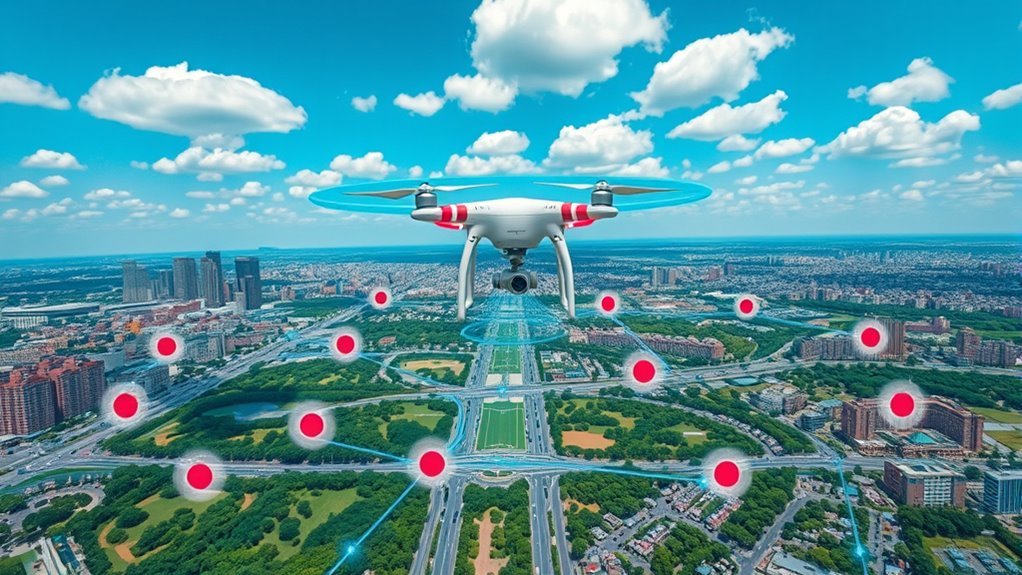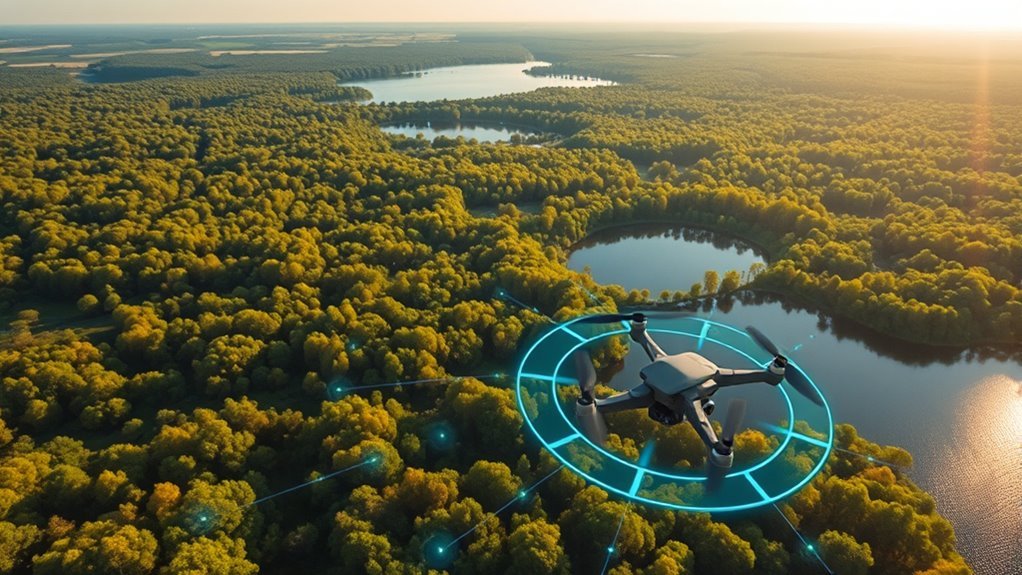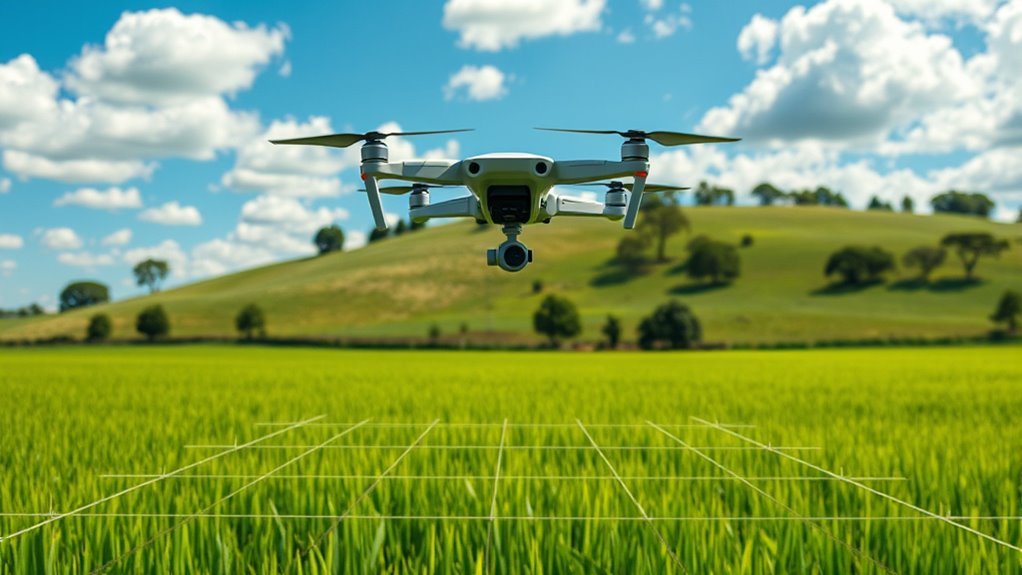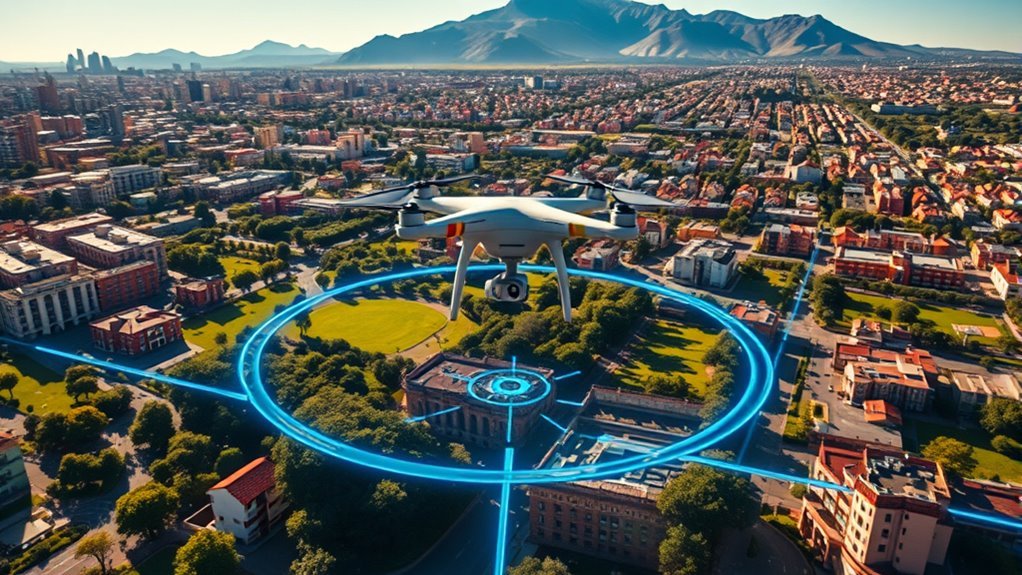You need to understand drone geofencing as a GPS-based system that sets virtual boundaries to restrict drone flights in sensitive or regulated airspace, enhancing safety and regulatory compliance. It continuously monitors your drone’s location, triggering alerts or automatic controls if boundaries are approached or crossed. Different geofence zones dictate permissible flight areas, and staying updated with firmware and regulations is critical. Mastering these core concepts is essential before exploring more advanced operational and legal considerations.
What Is Drone Geofencing?

Drone geofencing is a technology that creates virtual boundaries to restrict where a drone can fly. It enhances drone security by preventing unauthorized access to sensitive or hazardous areas. While this might seem like a limitation on your freedom, understanding these boundaries is essential for responsible operation. Effective user education plays a key role, ensuring you know how geofencing impacts flight paths and compliance requirements. By integrating geofencing, you gain a structured environment that balances operational freedom with safety protocols. This technology doesn’t aim to confine but to safeguard airspace, minimizing risks and potential conflicts with manned aircraft or restricted zones. Embracing geofencing equips you to fly confidently within designated parameters, enhancing both personal safety and broader airspace security.
How Drone Geofencing Technology Works

You’ll find that drone geofencing relies on defining virtual boundaries using GPS coordinates. The system continuously integrates data from onboard sensors and GPS modules to monitor the drone’s position relative to these zones. When the drone approaches or crosses a boundary, the technology triggers predefined responses to maintain safe operation.
Geofencing Mechanism Basics
Understanding how geofencing technology works is essential for grasping how drones maintain safe operational boundaries. At its core, geofencing relies on geofencing algorithms that define virtual perimeters around restricted or sensitive areas. These algorithms process real-time location data to determine whether your drone is approaching or breaching these boundaries. As you pilot your drone, the system continuously evaluates its position relative to these zones, dynamically influencing drone navigation decisions. This guarantees that your drone either avoids prohibited airspace or initiates corrective maneuvers automatically. By seamlessly integrating these algorithmic controls, geofencing technology balances operational freedom with regulatory compliance, allowing you to maximize your drone’s capabilities while respecting safety constraints. This foundational mechanism is critical for predictable, secure drone flights within designated airspace.
GPS and Sensor Integration
While geofencing algorithms set the boundaries, it’s the integration of GPS and onboard sensors that enables precise real-time positioning essential for enforcing these zones. You rely on GPS accuracy to determine your drone’s exact location relative to geofenced perimeters, but GPS signals alone can fluctuate due to environmental factors. That’s why sensor calibration is critical—it guarantees that inertial measurement units (IMUs), barometers, and magnetometers provide reliable supplementary data. By fusing GPS coordinates with calibrated sensor inputs through sensor fusion algorithms, your drone maintains stable, accurate positioning even in challenging environments. This precise integration allows geofencing systems to dynamically restrict movements, safeguarding airspace without compromising your operational freedom. Properly calibrated sensors combined with high GPS accuracy form the backbone of effective, real-time geofence enforcement.
Types of Geofencing Zones and Their Purposes

Geofencing zones are categorized based on their specific regulatory and operational functions, each designed to govern drone activity within defined boundaries. You’ll encounter restricted airspace zones that prohibit drone flights to prevent interference with manned aircraft or sensitive installations. Emergency zones temporarily limit drone access during incidents like natural disasters or law enforcement operations, ensuring safety and security. Controlled airspace zones allow limited drone operations under strict guidelines, balancing safety with operational freedom. Additionally, altitude-restricted zones regulate vertical flight limits to avoid conflicts with other air traffic. By understanding these zone types, you can navigate drone operations responsibly while maximizing your flight autonomy within legal constraints, ensuring you maintain both safety and freedom during your missions.
Benefits of Using Geofencing in Drone Operations
When you implement geofencing in drone operations, you greatly enhance flight safety by restricting access to sensitive areas. It also streamlines regulatory compliance by automatically enforcing no-fly zones and altitude limits. Additionally, geofencing minimizes unauthorized drone activity, protecting both property and public spaces from potential risks.
Enhancing Flight Safety
Although drone technology has advanced rapidly, ensuring safe flight operations remains a critical challenge that requires robust solutions. Geofencing enhances flight safety by dynamically controlling your drone’s flight path and performing real-time risk assessments to avoid hazardous zones. This technology empowers you to explore freely while minimizing collision risks and unauthorized incursions.
| Safety Aspect | Geofencing Benefit |
|---|---|
| Flight Path Control | Automatically restricts routes near hazards |
| Risk Assessment | Continuously evaluates surroundings |
| Collision Avoidance | Prevents entry into restricted airspace |
Regulatory Compliance Made Easy
Beyond improving flight safety, integrating geofencing into your drone operations simplifies adherence to complex regulatory frameworks. Geofencing automates compliance by dynamically restricting flight zones in accordance with the latest regulatory updates, ensuring you stay within legal boundaries without constant manual checks. This technology addresses compliance challenges by embedding up-to-date airspace restrictions directly into your drone’s navigation system, reducing the risk of inadvertent violations. By proactively managing no-fly zones and altitude limits, geofencing minimizes your operational risks and liability exposure. For operators valuing freedom, this means you can focus on mission execution rather than regulatory monitoring, knowing your system enforces compliance seamlessly. Ultimately, geofencing is an essential tool that streamlines regulatory adherence, enabling safer, more efficient, and legally sound drone operations.
Minimizing Unauthorized Access
Since unauthorized access to sensitive airspace can jeopardize both safety and security, employing geofencing technology is vital in drone operations. Geofencing minimizes unauthorized entry into restricted zones by enforcing virtual boundaries. This guarantees your drone respects no-fly areas without manual intervention. Here’s how it benefits you directly:
- Automated Compliance: Your drone automatically avoids or restricts flight in predefined restricted zones, reducing human error.
- Real-Time Alerts: Immediate notifications inform you when your drone approaches or attempts unauthorized entry, allowing prompt corrective action.
- Operational Freedom: By confidently avoiding restricted zones, you maintain operational freedom while adhering to airspace limitations.
Using geofencing, you balance the desire for autonomous flight freedom with the critical need to protect sensitive airspace against unauthorized access.
Legal Implications and Compliance Requirements
When operating drones within geofenced areas, you must navigate a complex landscape of legal obligations designed to guarantee safety and privacy. Your legal responsibilities include adhering to airspace restrictions, respecting no-fly zones, and ensuring data protection compliance. Failure to comply can result in significant penalties or operational bans. To maintain operational freedom, you need robust compliance strategies that integrate geofencing technology with regulatory frameworks. This involves real-time updates of geofence parameters aligned with evolving legislation, thorough documentation of flight logs, and proactive risk assessments. By systematically applying these strategies, you minimize legal exposure while preserving your ability to operate freely. Understanding and implementing these compliance requirements is essential to balance safety imperatives with your operational autonomy in geofenced environments.
Tips for Pilots to Maximize Geofencing Safety
Ensuring legal compliance is just one part of maintaining safety in geofenced drone operations; pilots play a direct role in maximizing this safety on the ground and in the air. To elevate your effectiveness using geofencing strategies, focus on these critical steps:
- Continuously update your drone’s firmware and geofencing databases to maintain pilot awareness of new or altered restricted zones.
- Conduct thorough pre-flight checks, verifying geofencing parameters are active and aligned with your mission’s geographic constraints.
- Employ real-time monitoring tools to detect and respond to geofence alerts promptly, preserving operational freedom while respecting airspace boundaries.

